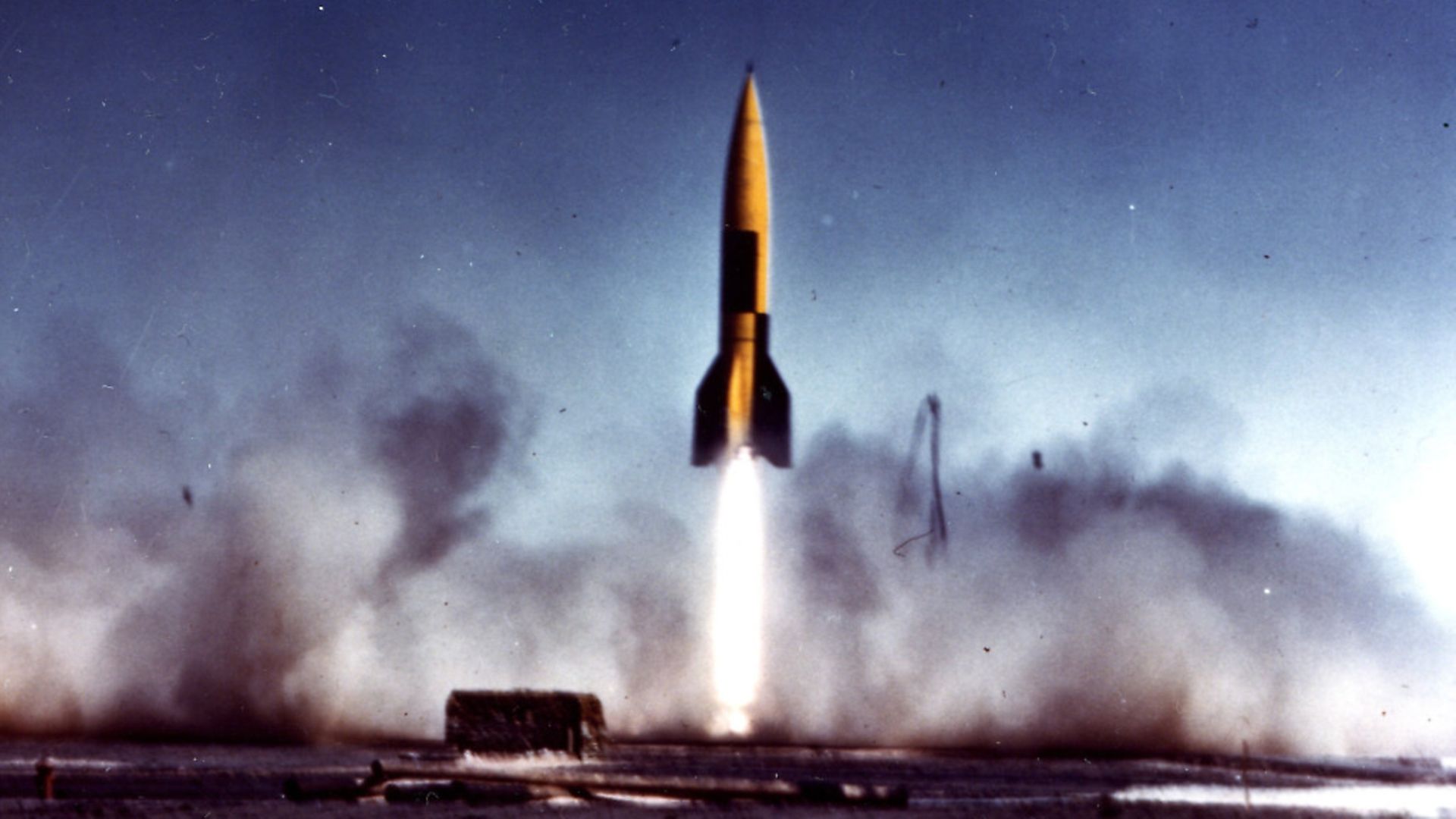
The V-2 was a mere footnote of the Second World War – despite the destructive power and terror it created. Yet, as Mick O’Hare shows, the lethal weapon was one of the most influential inventions of the 20th century
“The thing was, you couldn’t hear them coming. they travelled faster than the speed of sound so the first you heard was a huge explosion and there was a hole where your neighbour’s street was,” recalls Alf Grainger. “It put the fear of god into you.”
Londoners had reluctantly become used to the pulsing buzz of the Nazi V-1 flying bombs, or doodlebugs, throughout the summer of 1944, but as it drew to a close, a new weapon was about to be directed against the capital and other European cities. The V-2 missile (or Vengeance Weapon 2 as designated by Joseph Goebbels, the Nazi propaganda minister) was even more powerful and devastating. On September 8, 1944 it was launched on London and Paris in a desperate attempt by Germany to turn the tide of the Second World War following the Allied successes in the aftermath of D-Day. V-2s were certainly destructive, displacing 3,000 tonnes of material when they struck and creating a 20 metre-wide crater.
Alf Grainger was nine at the time and recalls the first V-2s striking on a drizzly September evening in Chiswick, west London. “You had no idea where they were going to fall, and unlike the doodlebugs there was no warning sound. No chance to take shelter.”
Yet while Londoners were rightly terrified of Germany’s new weapon it was never going to change the course of the war. “One of the great myths about the V-2 was that had it come earlier in the war it could have led to German victory,” says Michael Neufeld, historian of the German rocket programme and senior curator of the V-2 exhibit at the Air and Space Museum in Washington DC. “Neither the V-2 nor the V-1 could deliver the destructive force of a fully-laden four-engined bomber. V-2s were a terrifying psychological weapon, but they were nothing more than a footnote to the Second World War.”
Yet while many people know of the role they played in terrorising the people of London and western Europe in 1944, very few know of the part the V-2 would go on to play after the war. For Germany had not just invented a destructive weapon, it had invented the world’s first military missile, the first rocket to travel outside the Earth’s atmosphere and therefore the world’s first spacecraft. “They were inefficient, inaccurate and expensive,” adds Neufeld, also author of The Rocket and The Reich.
More than 6,000 were built but only about 3,500 were launched against the Allies and only 2,000 hit their targets. “More people died making them in Nazi labour camps, than were killed in the attacks,” Neufeld points out. But despite its brutal origins and blunt inefficiency the V-2 was a breakthrough technologically.
Its peacetime uses have been frequently overlooked, unsurprisingly considering the deadly reason for which it was first built. But in the years following the German defeat in 1945 the V-2 inspired the development of large liquid-propellant rocket engines, the very same technology that would go on to power nuclear missiles, send probes out into the solar system and satellites into orbit, and eventually launch the vehicles which would put humans into space and onto the surface of the moon.
The engine’s design had solved one of the key problems that others had struggled with. Its fuel pump was able to deliver a mix of liquid oxygen and alcohol fuel at a rate fast enough to allow the V-2 to become the first human-built object capable of leaving the Earth’s atmosphere and reaching the edge of space.
No wonder that, following Germany’s defeat, the Allies scrambled to capture intact examples. Most ended up in the hands of the Americans or the Soviets. The technology they discovered changed much of what they knew about rocketry.
The German designers, led by Nazi party member Wernher von Braun, had developed a guidance system that could operate independently of ground controllers. Using gyroscopes it could tip the vertically launched rocket over at an angle of about 45 degrees, at which point it was travelling at 5,600 kilometres per hour, in much the same the same way rockets are launched today – anybody who has watched a space shuttle take off cannot have failed to notice how it rolls and pitches. And vanes deflected the exhaust gases and airflow around the V-2 to ensure it stayed on trajectory. Look at the fins protruding from the base of the Saturn V rocket which took Apollo to the Moon. All these are technologies that first saw the light of day on the V-2.
“The engine system had an accelerometer which would cut out when the rocket reached its optimum speed,” explains Neufeld. “And it would tumble when it reached space but as soon as it re-entered the atmosphere, the fins would realign it,” just like a dart flying towards the bullseye.
Of course, it wasn’t only rocket hardware that the Allies sequestered after 1945. It was intellect and technological know-how too. Von Braun and many other technicians surrendered to the western powers, believing the Soviet Union was more likely to treat them as war criminals. And while Neufeld believes that America was morally corrupt for offering the avowed Nazi and SS member the chance to continue his work by turning a blind eye to his past, many people didn’t care. As Major General Holger Toftoy of the US Army Rocket Development Division said in 1946: “By using German V-2 missiles, our designers will save years of research and millions of dollars.”
Von Braun’s first work was on the US Army’s Redstone missile, a direct derivative of the V-2. And it was atop a modified Redstone that America’s first astronaut Alan Shepard was launched in 1961, shortly after Soviet cosmonaut Yuri Gagarin became the man in space aboard Vostok I. In 1960 von Braun had also been put in charge of developing the Saturn V rocket programme that would carry Apollo to the Moon and was widely lauded by the American establishment for his achievements.
It was his influence in part that led to Nasa adopting the Lunar Orbit Rendezvous (LOR) method of putting a man on the moon. A spacecraft would orbit the moon while a lander, carrying two astronauts would be despatched to the surface.
Von Braun’s reputation would eventually be exposed and toppled by investigative journalist Linda Hunt’s excoriating work US Coverup of Nazi Scientists published in the Bulletin of the Atomic Scientists in 1985. But by this time von Braun was eight years dead and the US government had successfully managed to keep any damaging information about its German scientists’ backgrounds covered up while they worked on the US space programme. They considered it a price worth paying – there is no doubt that the technological acumen von Braun and his colleagues possessed gave the US a winning advantage in the space race.
Meanwhile other German engineers such as Helmut Gröttrup were working for the USSR – some voluntarily, others coerced – under the guidance of Sergei Korolev, the director and mastermind behind the Soviet space programme, also using captured V-2s. This work led initially to the production of one of the Soviet Union’s first short-range ballistic missiles the R-1 and then the R-2 (or SS-2) first displayed at Kiev’s 1962 May Day parade.
The latter was also used to transport monkeys and other animals to the edge of space. But while the V-2 was to influence Soviet rocket designs in the run-up to the launch of the Sputnik satellites and then Vostok I in April 1961, the superior knowledge of von Braun would prove to be critical. The Russians struggled to create an effective launch vehicle for crewed flights to the moon, but von Braun’s Saturn V was overcoming its initial technical difficulties and would lead to American victory in the space race.
So without the V-2 would we have had Sputnik, Vostok I or even the Moon landings? Possibly, but not assuredly. The V-2 hugely advanced knowledge of rocketry and ballistics meaning that the two Cold War rivals both used the technology in their designs to take humans into orbit and beyond. But it was the Russian-American rivalry itself that drove the race to the Moon as the competing ideologies of communism and capitalism strove to prove that they were better than the other. Had the Cold War ended before Neil Armstrong or anybody else walked on the Moon, that imperative would have been nullified. Their governments might easily have lost interest and decided that their dollars or roubles were better directed elsewhere. The V-2 came at the right time, at the very start of the Cold War and at the very start of the space race.
And the V-2 has one more ‘first’ to its name. Although it was via modified V-2 technology that the heroics and disasters of the space race were played out, the very first picture of our planet from space came from a captured rocket. On October 24, 1946, a V-2 was launched from White Sands Missile Range in New Mexico. When it had climbed to 105 kilometres a camera in the nose took the first picture of the planet’s surface and the curvature of its horizon. The 35-millimetre negative was retrieved from the remains of the rocket after it crashed back to Earth. A V-2 had started the space race and V-2 technology would decide the outcome.
It was the world’s first spacecraft – today’s launchers still use gyroscopes for guidance and use liquid fuel power from similar engines. “We got to the Moon using V-2 technology,” says Doug Millard, senior curator and space historian at London’s Science Museum. “But it was technology developed with some grim resources.”
Now 83, Alf Grainger is one of a dwindling number of people who witnessed a V-2 attack. “If I’d have had my way they’d all have been dismantled after the war,” he says. One can empathise with the sentiment. But had it happened we might not, in 2019, also be celebrating the 50th anniversary of the first ever moonwalk.








